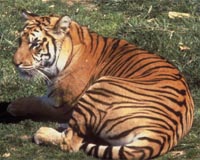| . |  |
. |
Bangkok (AFP) Sept 25, 2009 Scientists discovered 163 new species in Southeast Asia's Greater Mekong region last year, but all are at risk of extinction due to climate change, the WWF said in a report released Friday. The newly discovered creatures include a bird-eating frog with fangs, a bird that would rather walk than fly and a gecko whose alien appearance inspired the report's title of "Close Encounters", the conservation group said. The report was released ahead of major UN talks on climate change in Bangkok next week, which are being held before a make-or-break summit in Copenhagen this December. "Some species will be able to adapt to climate change, many will not, potentially resulting in massive extinctions," Stuart Chapman, director of the WWF Greater Mekong Programme, said in the report. "Rare, endangered and endemic species like those newly discovered are especially vulnerable because climate change will further shrink their already restricted habitats," he said. The new discoveries in 2008 include 100 plants, 28 fish, 18 reptiles, 14 amphibians, two mammals and a bird, the WWF report said. The area spans Cambodia, Laos, Myanmar, Thailand, Vietnam and China's Yunnan province. Among the new species is the bird-eating fanged frog, which remained hidden in a protected area of Thailand despite the fact that scientists were studying there for 40 years, the report said. The tiger-striped pitviper was discovered accidentally on an island off the coast of Vietnam when a scientist was looking for a lizard and his son pointed out that his hand was on a rock right next to the snake's fangs. "We caught the snake and the gecko and they both proved to be new species," researcher Lee Grismer of La Sierra University in California was quoted as saying in the report. The leopard gecko, found on another Vietnamese island, has the colouring of a leopard and bizarre orange, cat-like eyes and spindly limbs. Meanwhile the nonggang babbler is a new bird species found in small flocks in China near the Vietnamese border, which only flies for short distances when frightened, the report said. The Greater Mekong region has proved a fertile area for scientists. The WWF said in December 2008 that it had found 1,068 new species there between 1997 and 2007. But the report said that the region's climate was already changing, with rising seas and saltwater intrusion having a particular impact. The WWF stressed the importance of the penultimate negotiating session of the United Nations Framework Convention on Climate Change, starting in Bangkok on September 28, before the December Copenhagen meeting. World leaders in Copenhagen are expected to agree new targets for global emissions beyond 2012, when the Kyoto Protocol expires. "Protecting endangered species and vulnerable communities in the Greater Mekong and elsewhere around the world depends on fast progress at the UN talks in Bangkok," said Kathrin Gutmann, head of policy and advocacy at the WWF Global Climate Initiative. Share This Article With Planet Earth
Related Links Darwin Today At TerraDaily.com
 India's tiger protection plan 'failing': experts
India's tiger protection plan 'failing': expertsNew Delhi (AFP) Sept 23, 2009 India's efforts to stop poaching of its endangered tigers are failing despite millions of dollars of funding, a new protection force and experiments with animal transfers, experts say. The federal government swung into action in 2007 after India's tiger population plunged to just 1,350 -- just over a third of the 3,700 estimated to be alive in 2002. A new tiger conservation plan chalked ... read more |
|
| The content herein, unless otherwise known to be public domain, are Copyright 1995-2009 - SpaceDaily. AFP and UPI Wire Stories are copyright Agence France-Presse and United Press International. ESA Portal Reports are copyright European Space Agency. All NASA sourced material is public domain. Additional copyrights may apply in whole or part to other bona fide parties. Advertising does not imply endorsement,agreement or approval of any opinions, statements or information provided by SpaceDaily on any Web page published or hosted by SpaceDaily. Privacy Statement |